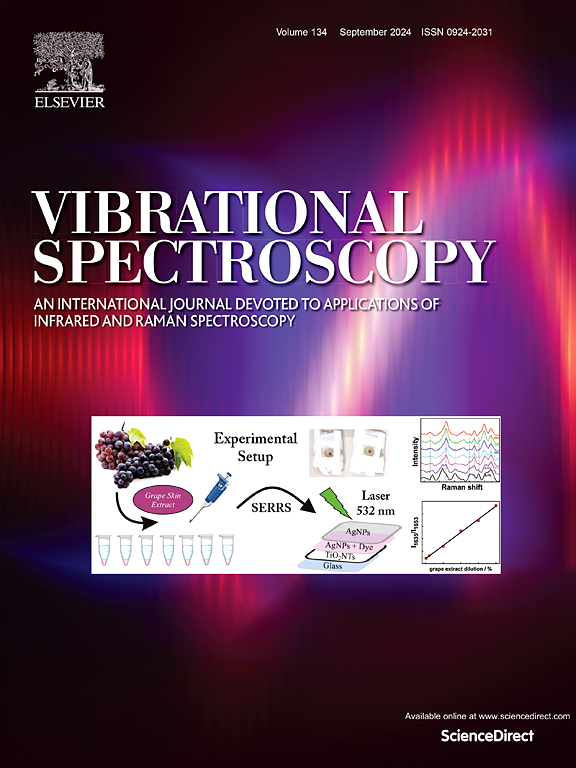Real-time monitoring of multiparameter in 1,3-propanediol production process with near-infrared spectroscopy
IF 3.1
3区 化学
Q2 CHEMISTRY, ANALYTICAL
引用次数: 0
Abstract
1,3-propanediol (1,3-PDO) is a significant product of fermentation, with glycerol serving as the primary substrate in most cases. Bioprocess control based on real-time information of feedstock and main products is crucial for reducing the cost of production. However, rapid quantification of 1,3-PDO and glycerol remains challenging due to their highly similar molecular structures. In this study, the feasibility of near-infrared (NIR) spectroscopy to monitor 1,3-PDO, glycerol, acetate, and butyrate concentrations in the fermentation process using strain Clostridium pasteurianum was evaluated. NIR spectra were acquired through at-line measurement involving sampling and ex-situ analysis or on-line measurement with a fiber optic probe immersed in fermentation broth, integrated with Partial Least Squares (PLS) regression to establish calibration models on a laboratory-scale and pilot-scale. The best PLS regressions of 1,3-PDO, glycerol, acetate, and butyrate with two measurement approaches provided excellent performance, with the root-mean-squared errors of prediction (RMSEP) of 1.656 g/L, 1.502 g/L, 0.746 g/L, and 0.557 g/L in at-line measurement and 1.113 g/L, 1.581 g/L, 0.415 g/L, and 0.526 g/L in on-line measurement. The cross-scale application performance of at-line measurement was evaluated by an external fermentation trial and an acceptable result was achieved. At-line measurement technique represents a superior choice for the optimization of fermentation process since the robustness across varying fermentation scales and its applicability in multiple bioreactors. Thus, a calibration model developed for one bioreactor is likely to be used in other bioreactors, which enables the reduction of modeling costs. On-line measurement technique, owing to its automated operation and frequent data acquisition, enables real-time monitoring and precise control of the fermentation process, thereby reducing cost and improving production efficiency.
1,3-丙二醇生产过程多参数的近红外光谱实时监测
1,3-丙二醇(1,3- pdo)是发酵的重要产物,在大多数情况下甘油作为主要底物。基于原料和主要产品实时信息的生物过程控制对于降低生产成本至关重要。然而,1,3- pdo和甘油的快速定量仍然具有挑战性,因为它们的分子结构非常相似。在本研究中,评估了近红外(NIR)光谱监测巴氏梭菌发酵过程中1,3- pdo、甘油、乙酸和丁酸浓度的可行性。近红外光谱通过采样和非原位分析的在线测量或浸泡在发酵液中的光纤探针在线测量获得,并结合偏最小二乘(PLS)回归建立实验室规模和中试规模的校准模型。两种测量方法对1,3- pdo、甘油、乙酸酯和丁酸酯的最佳PLS回归具有良好的性能,在线测量的均方根预测误差(RMSEP)分别为1.656 g/L、1.502 g/L、0.746 g/L和0.557 g/L,在线测量的RMSEP分别为1.113 g/L、1.581 g/L、0.415 g/L和0.526 g/L。通过外部发酵试验,对在线测量的跨尺度应用性能进行了评价,取得了可接受的结果。在线测量技术由于其在不同发酵规模上的稳健性和在多种生物反应器中的适用性,是优化发酵过程的一种优越选择。因此,为一个生物反应器开发的校准模型可能用于其他生物反应器,从而降低建模成本。在线测量技术由于其自动化操作和频繁的数据采集,可以实时监测和精确控制发酵过程,从而降低成本,提高生产效率。
本文章由计算机程序翻译,如有差异,请以英文原文为准。
求助全文
约1分钟内获得全文
求助全文
来源期刊

Vibrational Spectroscopy
化学-分析化学
CiteScore
4.70
自引率
4.00%
发文量
103
审稿时长
52 days
期刊介绍:
Vibrational Spectroscopy provides a vehicle for the publication of original research that focuses on vibrational spectroscopy. This covers infrared, near-infrared and Raman spectroscopies and publishes papers dealing with developments in applications, theory, techniques and instrumentation.
The topics covered by the journal include:
Sampling techniques,
Vibrational spectroscopy coupled with separation techniques,
Instrumentation (Fourier transform, conventional and laser based),
Data manipulation,
Spectra-structure correlation and group frequencies.
The application areas covered include:
Analytical chemistry,
Bio-organic and bio-inorganic chemistry,
Organic chemistry,
Inorganic chemistry,
Catalysis,
Environmental science,
Industrial chemistry,
Materials science,
Physical chemistry,
Polymer science,
Process control,
Specialized problem solving.
 求助内容:
求助内容: 应助结果提醒方式:
应助结果提醒方式:


